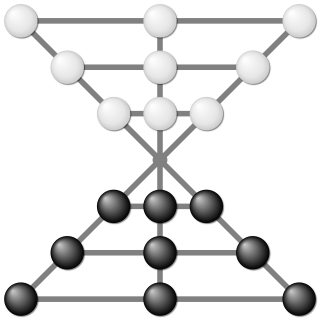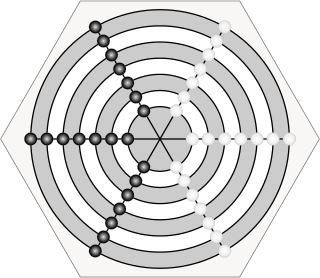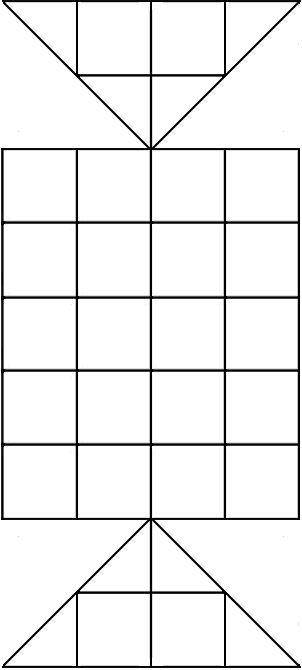
Alquerque is a strategy board game that is thought to have originated in the Middle East. It is considered to be the parent of draughts and Fanorona.
Permainan-Tabal is a two-player abstract strategy board game from Indonesia. The game is sometimes referred to as a cross between Alquerque and Draughts. It is essentially Draughts played on an expanded Alquerque board. It is especially similar to Draughts in that the moves of the pieces are strictly forward and sideways until they are promoted to Kings by reaching the other player's first rank. The game is also referred to as Dama.
Main tapal empat is a two-player abstract strategy board game from Malaysia. It is a hunt game, and specifically a tiger hunt game since it uses an Alquerque board. The tigers can move as many spaces in a straight line as a clear path allows. Most hunt games have tigers, leopards, or foxes moving only one space at a time. In effect, the tigers in this game have the movement capability of the queen in chess.

Lau kata kati is a two-player abstract strategy game from India, specifically from Lower Bengal, and also from United Provinces, Karwi Subdivision where it is called Kowwu Dunki, and it was described by H.J.R. Murray in A History of Board-Games Other Than Chess (1952). The game is related to draughts and even more so to Alquerque. Pieces are captured by leaping over them. The board is a pattern of two triangles joined together at a common vertex with further lines subdividing them. It is the same game as Butterfly (game) from Mozambique, which suggests a historical connection between the two games. Lau kata kati belongs to a specific category of games called Indian War-games, and the other games in this category are Dash-guti, Egara-guti, Pretwa, Gol-skuish. All Indian War-games have one important thing in common, and that is that all the pieces are laid out on the patterned board, with only one vacant point in the center. This forces the first move to be played on the central point, and captured by the other player's piece.
Dash-guti is a two-player abstract strategy board game from India, specifically from Central Provinces, United Provinces, Karwi Subdivision where it is called Kowwu Dunki which is the same name given to another similar game called Lau kata kati, and it was described by H.J.R. Murray in A History of Board-Games Other Than Chess (1952). The game is related to Draughts and even more so to Alquerque. Pieces are captured by leaping over them. Dash-guti consists of a Lau kata kati board, but with the addition of two line segments connected to the vertex but exterior to both triangles. Dash-guti belongs to a specific category of games called Indian War-games, and the other games in this category are Lau kata kati, Egara-guti, Pretwa, Gol-skuish. All Indian War-games have one important thing in common, and that is that all the pieces are laid out on the grid patterned board, with only one vacant point in the centre. This forces the first move to be played on the central point, and captured by the other player's piece.
Egara-guti is a two-player abstract strategy game from India, specifically from Central Provinces, and it was described by H.J.R. Murray in A History of Board-Games Other Than Chess (1952). The game is related to Draughts and even more so to Alquerque. Pieces are captured by leaping over them. Egara-Guti consists of a Lau kata kati board, but with the addition of two lines connecting the two triangles and running through them. Egara-guti belongs to a specific category of games called Indian War-games; some other games in this category are Lau kata kati, Dash-guti, Pretwa, Gol-skuish. All Indian War-games have one important thing in common, and that is that all the pieces are laid out on the grid patterned board in the beginning, with only one vacant point in the center. This forces the first move to be played on the central point, and captured by the other player's piece.

Pretwa is a two-player abstract strategy game from Bihar, India, and it was described by H.J.R. Murray in A History of Board-Games Other Than Chess (1952). The game is related to draughts and Alquerque as pieces are captured by leaping over them. The board is composed of three concentric circles divided by three diameters. Pretwa belongs to a category of games called Indian war games, which also includes the games Lau kata kati, Dash-guti, Egara-guti, Gol-skuish. All Indian war games have one important thing in common, and that is that all the pieces are laid out on the board at every intersection point, with the exception of the central point. This forces the first move to be played on the central point, and captured by the other player's piece.

Gol-skuish is a two-player abstract strategy game from India, specifically from Central Provinces, and it was described by H.J.R. Murray in A History of Board-Games Other Than Chess (1952). The game belongs to the draughts and Alquerque family as pieces are captured by leaping over them. The board is composed of seven concentric circles divided by three diameters. Gol-skuish belongs to a specific category of games called Indian War-games which include Lau kata kati, Dash-guti, Egara-guti, and Pretwa. At the beginning of every Indian War-game all the pieces are laid out on the board at every intersection point, with the exception of the central point. This forces the first move of the game to be played on the central point, and captured by the second player's piece.
Felli is a two-player abstract strategy board game from Morocco. It is related to Alquerque and draughts as pieces leap over one another to capture. Felli's closest relatives are several thousand miles away in the form of Lau kata kati from India and the game called Butterfly from Mozambique. One main difference is that the Felli board has only one horizontal line across its breadth as opposed to two found in the other two games.
Zamma is a two-player abstract strategy game from Africa. It is especially played in North Africa. The game is similar to alquerque and draughts. Board sizes vary, but they are square boards, such as 5x5 or 9x9 square grids with left and right diagonal lines running through several intersection points of the board. One could think of the 5x5 board as a standard alquerque board, but with additional diagonal lines, and the 9x9 board as four standard alquerque boards combined, but no additional diagonal lines are added. The initial setup is also similar to alquerque, where every space on the board is filled with each player's pieces except for the middle point of the board. Furthermore, each player's pieces are also set up on their respective half of the board. The game specifically resembles draughts in that pieces must move in the forward directions until they are crowned "Mullah" which is the equivalent of the king in draughts. The Mullah can move in any direction. In North Africa, the black pieces are referred to as men, and the white pieces as women. In the Sahara, short sticks represent the men, and camel dung represent the women.

Kharbaga is a two-player abstract strategy game from North Africa. In a way, it is a miniature version of Zamma; however, there are more diagonal lines per square on the board as compared to Zamma. The game is considered part of the Zamma family. The game is also similar to Alquerque and draughts. The board is essentially an Alquerque board with twice the number of diagonal lines or segments allowing for greater freedom of movement. The initial setup is also similar to Alquerque, where every space on the board is filled with each player's pieces except for the middle point of the board. Moreover, each player's pieces are also set up on each player's half of the board. The game specifically resembles draughts in that pieces must move in the forward directions until they are crowned "Mullah" which is the equivalent of the King in draughts. The Mullah can move in any direction.
Dablo is a family of two-player strategy board games of the Sámi people. Different variants of the game have been played in different parts of Sápmi.
Tiger game played with forty, translation of meurimueng-rimueng peuet ploh, is a two-player abstract strategy board game from Sumatra, Indonesia. The last part of the name, ploh, is sometimes spelled "plo". It is specifically played by the Acehnese. The game was described in The Achehnese by Hurgronje, O'Sullivan, and Wilkinson in 1906 and described on page 204.
Fetaix is a two-player abstract strategy board game from Morocco. It is very similar to Alquerque. The only difference is that pieces cannot move backwards until they are promoted to Mullah which is the equivalent of King in draughts. Furthermore, Mullahs can move any number of vacant points on the board, and capture enemy pieces from any distance similar to the Kings in International draughts. Another name for the game is qireq.
Kotu Ellima is a two-player abstract strategy board game from Sri Lanka played by the Sinhalese people. The game was documented by Henry Parker in Ancient Ceylon: An Account of the Aborigines and of Part of the Early Civilisation (1909); the game was printed as "Kotu Ellima" which is actually a misspelling because his source for the game was Leopold Ludovici's Journal of the Ceylon Branch of the Royal Asiatic Society (1873), and specifically in the chapter entitled "The Sports and Games of the Singhalese", and Ludovici wrote the name of the game as Kotu Ellime or Taking of the Castles. The game is similar to draughts (checkers) and Alquerque as players hop over one another's pieces to capture them; it is more similar to Alquerque between the two since it uses a standard Alquerque board. However, unlike draughts and standard Alquerque, the game is played on an expanded Alquerque board consisting of four triangular boards attached to the four sides of a standard Alquerque board. It closely resembles Peralikatuma and Sixteen Soldiers which are also played in Sri Lanka and other parts of the Indian subcontinent with the only difference being the number of pieces. In Sixteen Soldiers, each player has 16 pieces hence the name of the game. In Peralikatuma, each player has 23 pieces. In Kotu Ellima, each player has 24 pieces, and at the beginning of the game the whole board is covered with them except the central point reminiscent of standard Alquerque.
Tûkvnanawöpi is a two-player abstract strategy board game played by the Hopi native American Indians of Arizona, United States. The game was traditionally played on a slab of stone, and the board pattern etched on it. Tukvnanawopi resembles draughts and Alquerque. Each player attempts to capture each other's pieces by hopping over them. It is unknown how old the game is; however, the game was published as early as 1907 in Stewart Culin's book "Games of the North American Indians Volume 2: Games of Skill".
Tuknanavuhpi' is a two-player abstract strategy board game played by the Hopi Native American Indians of Arizona, United States. It is also played in many parts of Mexico. The game was traditionally played on a slab of stone with the board pattern etched on it. Tukvnanawopi resembles draughts and Alquerque. Players attempt to capture each other's pieces by hopping over them. It is not known when the game was first played; however, the game was published as early as 1907 in Stewart Culin's book Games of the North American Indians Volume 2: Games of Skill.
Awithlaknannai Mosona is a two-player strategy board game from the Zuni Native American Indian tribe of New Mexico, United States. It is unknown how old the game is. The game was described by Stewart Culin in his book "Games of the North American Indians Volume 2: Games of Skill" (1907). In this book, it was named Awithlaknan Mosona. Awithlaknannai Mosona resembles another Zuni board game called Kolowis Awithlaknannai with few minor differences. The former having a smaller board, and depending upon the variant, it also has less lines joining the intersection points. The rules are the same. Awithlaknannai Mosona belongs to the draughts and Alquerque family of games as pieces hop over one another when capturing. It is actually more related to Alquerque, since the board is made up of intersection points and lines connecting them. It is thought that the Spanish had brought Alquerque to the American Southwest, and Awithlaknannai Mosona may have been an evolution from Alquerque. However, in Stewart Culin's 1907 book, the Zunis claim that they had adopted a hunt game from Mexico similar to Catch the Hare and the Fox games of Europe, and transformed it into Awithlaknannai Mosona. In these games, one player has more pieces over the other, however, the other player's piece has more powers. The Zuni's equalized the numbers of pieces and their powers, and also may have transformed the board making its length far exceed its width. Diagonal lines also replaced orthogonal lines altogether. However, the hunt game from Mexico may have used an Alquerque board even though the game mechanics of their new game, Awithlaknannai Mosona, were completely different.
Terhüchü is a two-player abstract strategy board game from Nagaland in Northeast India and is played by the Angami Naga ethnic group. The game was documented as Terhüchü by John Henry Hutton in The Angami Nagas, With Some Notes on Neighboring Tribes (1921). According to Hutton, Terhüchü means "Fighting-eating" because the two opposing pieces are fighting and eating each other. There are a few variations of the game under the term Terhüchü, and all of them are similar to draughts and Alquerque as players hop over one another's pieces to capture them; they are most similar to Alquerque as a standard Alquerque board is used instead of a checkered square board, and in one variant eight triangular board sections are attached to the four sides and the four corner vertices of the Alquerque board. Each triangular board section is a triangle that is cross-sliced yielding an additional 48 intersections or vertices to the 25 points of the standard Alquerque board which yields a total of 73 points on the board. Each triangle is adjoined to the Alquerque board at one of its three vertices. Each triangle is cross-sliced in such a way that a line segment is drawn from the adjoining vertex to the base of the triangle with the other line segment drawn across the breadth of the triangle. As in Alquerque, pieces can move and capture in any available direction at any time during the game following the pattern of the board.

Astar is a two-player abstract strategy board game from Kyrgyzstan. It is a game similar to draughts and Alquerque as players hop over one another's pieces when capturing. However, unlike draughts and Alquerqe, Astar is played on 5x6 square grid with two triangular boards attached on two opposite sides of the grid. The board somewhat resembles those of Kotu Ellima, Sixteen Soldiers, and Peralikatuma, all of which are games related to Astar. However, these three games use an expanded Alquerque board with a 5x5 square grid with diagonal lines. Astar uses a 5x6 grid with no diagonal lines.






